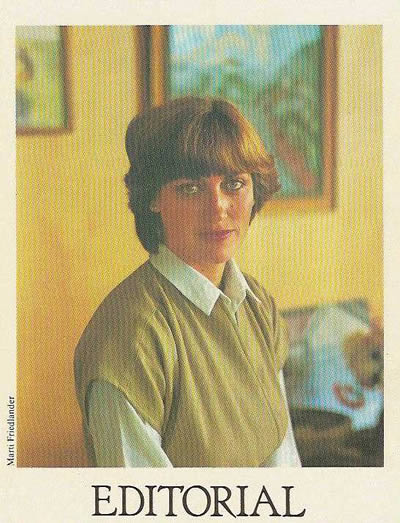I like buying old books on the island. You'll sometimes find interesting inscriptions in the dust jacket: a poet's dedication to a friend, her book now discarded. At the Ostend market on Saturday, there was a cache of alternative publications in storage since the 70s (most of them deservedly so). The Journal of Cannabis Therapeutics. A collection of essays entitled Scientific controversies: Case studies in the resolution and closure of disputes in science and technology.
And then, at The Junk Shop, there was The New Zealander. Issue two, September 1980: someone kept it for a long time.
Deborah Coddington gazes out from the editor's page, impossibly winsome in her Lady Di hairdo:

But the rhetorical style is already in place: "It is long past time for people who choose to live in this country stop their servile acceptance of glibly strung-together negatives about New Zealand," she rails. "Kiwi modesty is fine, but self-flagellation with nihilistic criticism is simply a waste of time. We are tired of the whingers who fail to contribute then moan about the state of the nation. The New Zealander is the showpiece for all that is best in New Zealand and proof that New Zealand has a lot to be proud of."
Proof? I'm not so sure. It's a bit of a hodge-podge, an opportunity for Alister Taylor to junket his way with the wife through various restaurants and Huka Lodge, then write, really dreadfully, about it. But the contributors' list is amazing: John A Lee, Robin Morrison, Dick Frizzell, Marcia Russell, Julie Dalzell, Louise Callan, Marti Friedlander, Hamish Keith, Rosemary McLeod, Tim Shadbolt, Judith Fyfe and others. I can't say if they all got paid.
The best thing in it is Maggie Tully's fascinating profile of Eva Rickard (photographs by Friedlander). Then Hamish Keith, the groovy old bastard, hails "the incredible flowering of New Zealand pop music of the past two or tree years," arguing that "the hard, gritty and challenging urban rock and new wave sound that rolls around hundreds of New Zealand pubs and clubs is a genuine cultural manifestation."
Lee, before expounding on the theory of import substitution (perhaps our ultimate economic period piece), has this to say: "We wrestle with explosions in liberated countries, while oil states too long treated as second-class nations bring industrial states to their knees. Mohammendanism is suddenly a political faith riding a tide of economic upheaval."
Judith Fyfe flits through a summary of a busy past year: Erebus … Arthur Alan Thomas gets his royal pardon … expulsion of the Russian ambassador, accused by Muldoon of interfering with domestic politics … Matt Rata resigns from Labour to form Mana Motuhake. Lange bumps out Bob Tizard as deputy leader … A rahui is placed on "the use of drugs by Maoris".
Our first million-dollar lottery, the "double-banger" Golden Kiwi, induced New Zealanders to queue down the street to pay $20 a ticket ("reminiscent of the 1930s dance marathons", ventures Fyfe ... the price of gold spiked (this was headline news over the course of months) … the "drug conspiracy" was the subject of a documentary that was withheld from broadcast …
And … we had a Commission of Inquiry into Chiropratic?
You may have detected that I'm fascinated by these fin de siecle years, which lie the far side of the river of no return. I was there, but young enough to be blameless.
The magazine is an affirmation that the aspirational culture was in place even in the latter days of the Polish shipyard era; pre Metro, before the market cowboys. "Lots of money and style - or so they thought," as a Trade Me vendor put it last July in the billing for the three issues.
There's an advertorial shopping section called It's Only Money. Curiously, most items are unpriced, but the National NE5640 microwave oven is listed at $799. (You'd have been better snaffling eight copies of the limited edition -- 125 -- screenprint of Gordon Walters' 'Arahua', offered to readers on pre-order a few pages later for a staggeringly good $95 each.)
There are some breathtaking food horrors. Carthews of Ponsonby Road (speciality: Cajun) offers the Budapest Starter: camembert and apple deep fried in batter, and served on a bed of apple puree. Eew. Even the Huka Lodge feels obliged to offer its wild boar in the ubiquitous "sweet and sour" preparation.
The ad creative is a surprise: some of it is rather nice, and artistic; gloriously dated. A great collage ad by Bremworth (carpet) and Ashley (wall coverings) stands out. An ad for Lion Export features a wiry, discombobulated chap called Mark Champtaloup (a rag-trade name who apparently needed no introduction at the time), looking, I fancy, like a youthful Steve Braunias ("During my two years away, I tried lots of lagers. After my first Lion Export, I knew what I'd been missing"). Modernity intrudes brashly with a Steinlager ad featuring a woman's torso. The 80s loom.
With its soft, plucky profiles of New Zealanders doing well overseas, The New Zealander connects, perhaps with Planet and Pavement a decade later. But these are people petitioning for admission to the establishment, not celebrating street culture. The generation that a quarter century later looks to outrace its own children down Ponsonby Road seemed to want to grow up. It's all so, so baby-boomer.